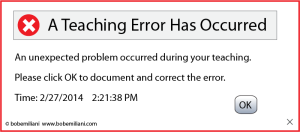Many people think that because Toyota has been en exemplary Lean practitioner for decades that they have perfect processes and few problems. That’s not true; none of their processes are perfect and they have many problems. What they do have is a willingness to be accept the existence of problems and the discipline to correct them using structured problem-solving processes.
 Likewise, some people think that my work applying Lean principles and practices to teaching has resulted in perfect processes and few problems. That’s not true. My processes are far from perfect and I have many problems. I make errors every day. I make errors in presenting learning materials or assignments, and students make errors in interpretation or execution. Like Toyota people, I accept the existence of problems and have the developed the discipline to correct them using structured problem-solving processes.
Likewise, some people think that my work applying Lean principles and practices to teaching has resulted in perfect processes and few problems. That’s not true. My processes are far from perfect and I have many problems. I make errors every day. I make errors in presenting learning materials or assignments, and students make errors in interpretation or execution. Like Toyota people, I accept the existence of problems and have the developed the discipline to correct them using structured problem-solving processes.
While the type and significance of the errors vary, I am diligent about documenting errors and correcting them immediately or within hours (in most cases). I am driven by an intolerance for errors, especially the possibility that errors will be repeated. To me, an error signifies and abnormal condition that requires immediate attention. Also, repetition of errors consumes resources (mine or students’) and detracts from the value of higher education.
The process I use is simple: The Plan-Do-Study-Adjust (PDSA) cycle. I think deeply about all aspects of my work. Are things working out as planned, or are there variances to plan? Then, I do my work, and while doing my work I look for errors (self or others). What are the errors, what is causing the errors, and who are they affecting? Next, I correct errors, and then I evaluate the improvement to see if the things I did were effective at correcting the errors and preventing future errors. I also check to see if the improvement has inadvertently created new errors. In other words, I do kaizen every day.
The alternative to daily improvement is to allow problems to pile up over time, which creates a seemingly insurmountable barrier for improvement. But, the way forward to to just get started by correcting the errors that do the most harm to students. Errors every day means kaizen every day. That is what people do – at least those who want to be known as “professionals.”
